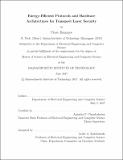| dc.contributor.advisor | Anantha P. Chandrakasan. | en_US |
| dc.contributor.author | Banerjee, Utsav | en_US |
| dc.contributor.other | Massachusetts Institute of Technology. Department of Electrical Engineering and Computer Science. | en_US |
| dc.date.accessioned | 2017-10-18T14:42:37Z | |
| dc.date.available | 2017-10-18T14:42:37Z | |
| dc.date.copyright | 2017 | en_US |
| dc.date.issued | 2017 | en_US |
| dc.identifier.uri | http://hdl.handle.net/1721.1/111861 | |
| dc.description | Thesis: S.M., Massachusetts Institute of Technology, Department of Electrical Engineering and Computer Science, 2017. | en_US |
| dc.description | This electronic version was submitted by the student author. The certified thesis is available in the Institute Archives and Special Collections. | en_US |
| dc.description | Cataloged from student-submitted PDF version of thesis. | en_US |
| dc.description | Includes bibliographical references (pages 99-104). | en_US |
| dc.description.abstract | The Internet of Things (IoT) has introduced a vision of an Internet where computing and sensing devices are interconnected. Digitally connected devices are encroaching on every aspect of our lives, including our homes, cars, offices, and even our bodies. Researchers estimate that there will be over 50 billion wireless connected devices by 2020 [1]. On one hand, the IoT enables fundamentally new applications, but on the other, these devices are attractive targets for cyber attackers, thus making IoT security a major concern. Datagram Transport Layer Security (DTLS) is considered to be one of the most suited protocols for securing the IoT. However, computation and communication overheads make it very expensive to implement DTLS on resource-constrained IoT sensor nodes. In this work, we profile the energy costs of DTLS version 1.3, using experimental models for cryptographic computations and radio-frequency (RF) communications. Based on this analysis, we propose protocol optimizations that can reduce the overall energy consumption of DTLS up to 45%, while still maintaining the same security strength of the standard DTLS. We discuss energy-efficient architectures for implementing the standard cryptographic primitives AES (Advanced Encryption Standard), SHA (Secure Hash Algorithm) and ECC (Elliptic Curve Cryptography) in hardware. Our hardware can provide more than 2,500 times reduction in energy consumption compared to traditional software implementations. These hardware primitives are integrated with dedicated control and memory to design a DTLS co-processor that can accelerate the complete DTLS state machine in hardware, thus minimizing the energy consumption due to DTLS computations. The proposed DTLS core is integrated with a RISC-V micro-processor to accurately profile these functions, as well as design custom protocols using standalone cryptographic instructions. | en_US |
| dc.description.statementofresponsibility | by Utsav Banerjee. | en_US |
| dc.format.extent | 104 pages | en_US |
| dc.language.iso | eng | en_US |
| dc.publisher | Massachusetts Institute of Technology | en_US |
| dc.rights | MIT theses are protected by copyright. They may be viewed, downloaded, or printed from this source but further reproduction or distribution in any format is prohibited without written permission. | en_US |
| dc.rights.uri | http://dspace.mit.edu/handle/1721.1/7582 | en_US |
| dc.subject | Electrical Engineering and Computer Science. | en_US |
| dc.title | Energy-efficient protocols and hardware architectures for transport layer security | en_US |
| dc.type | Thesis | en_US |
| dc.description.degree | S.M. | en_US |
| dc.contributor.department | Massachusetts Institute of Technology. Department of Electrical Engineering and Computer Science | |
| dc.identifier.oclc | 1005227047 | en_US |
